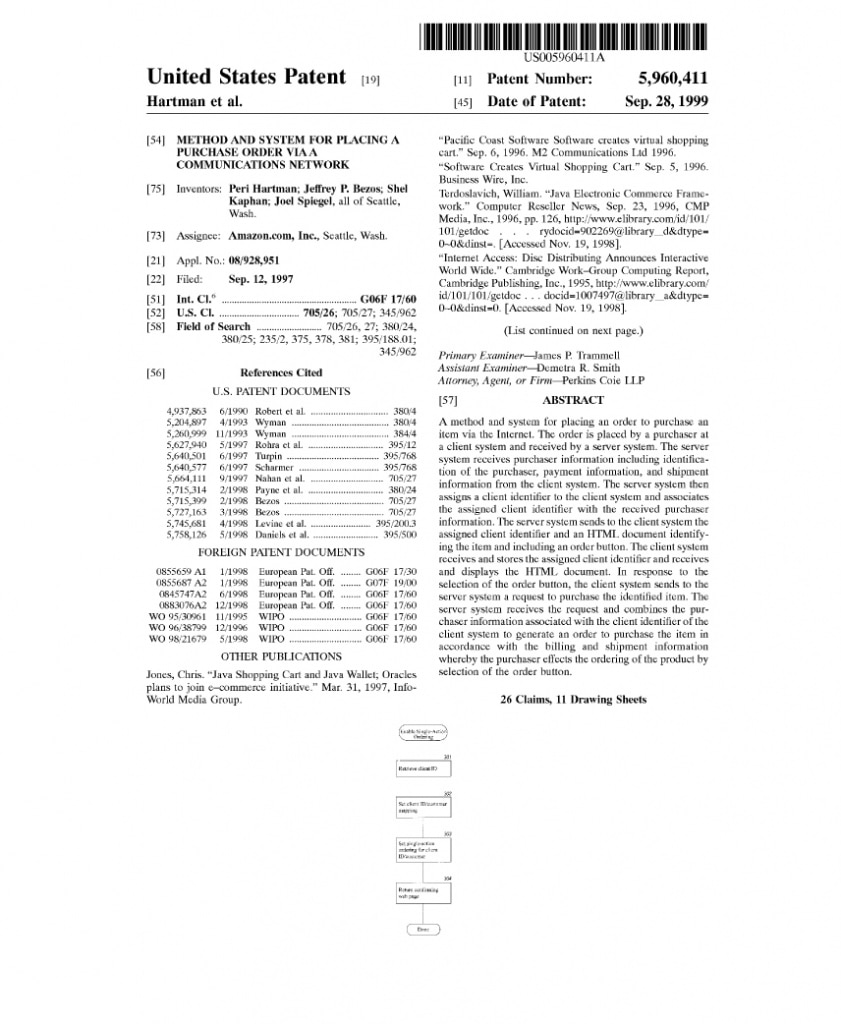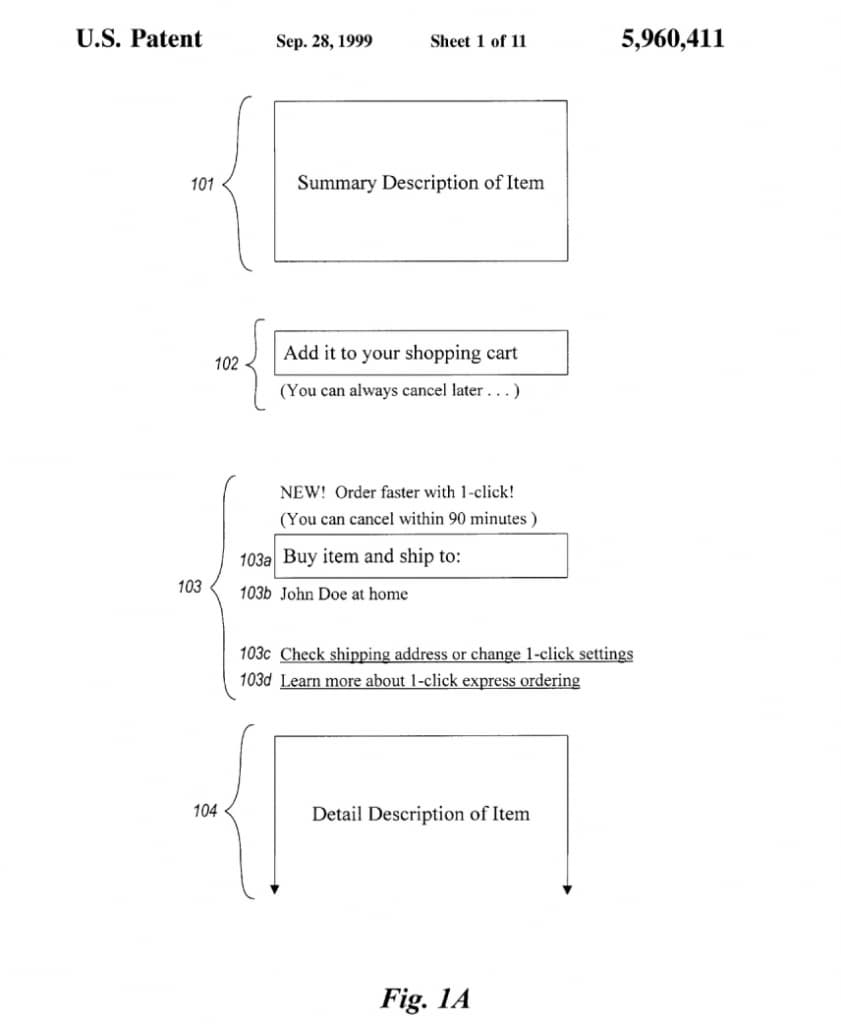Valuable patents solve contradictions
Amazon’s One-Click patent is the epitome of “non-obviousness”
Inventions are not obvious – they have to solve some kind of contradiction.

This idea holds true for businesses. Startups that can solve a contradiction in the market have a particular advantage – and so do patents.
One of the most talked-about inventions 10 or 15 years ago was Amazon’s One-Click patent. This patent was widely touted as being “obvious,” as we will see, it was anything but obvious.
I have always been interested in inventing. Growing up, I wanted to be an engineer. The highest honor of an engineer was not the Nobel Prize, but getting a patent. The patent represented a huge accomplishment.
I wrote up my first invention disclosure at my first job right out of college. That disclosure did not go anywhere, and I did not get my first patent until my next job. By the time I switched from my 13 year career as an engineer into a career in patent law, I had a dozen or so patents.
My goal at the time I switched to patent law was to license my ideas.
TRIZ and the art of solving a contradiction
About this time, I ran across TRIZ. TRIZ is a systematic way to invent, and at its core, TRIZ requires contradictions.
TRIZ was developed by Genrich Altshuller, a Russian who assembled a huge body of research on inventing. TRIZ (pronounced “trees”) is the Russian acronym for Theory of Inventing Problem Solving.
TRIZ, and inventing in general, is a process of solving contradictions. The TRIZ methodology is to formulate a problem in the form of a contradiction.
For example, an optimal boat would be fast and stable. Boats that are stable, tend to have wide hulls but they are slow. Boats that are fast have thin, narrow, long hulls but rock back and forth easily. This is analogous to the old business adage that you can only get two of “good, fast, or cheap.”
What is the solution to our boat problem?
It is a catamaran. Two hulls that are long and thin are very fast through the water, but incredibly stable.
At its heart, a good business model also solves a contradiction. The old way of doing things had certain problems. It was either trying to be the big, slow boat that was stable yet not fast. Or, it was the fast, sleek boat what had stability problems. Our startup company solves that contradiction in the marketplace with a new solution.
Amazon’s One-Click patent is non-obvious because it solves a contradiction
Amazon’s One-Click Patent is the perfect example of non-obviousness and a contradiction.
Remember back when the Internet was just getting started. Internet security was a huge problem, and there were widespread fears of sending your credit card over the Internet. At the early part of the growth, most companies would have you go through a huge process to find the right product, only to have you call a 1-800 number to give them your credit card. As browser technologies developed, secure web sites became commonplace but that lingering fear of sending your credit card information remained.
Another big problem with online commerce was fraud.
There was fraud on the part of the merchants, who would sell a product, collect the money, and would never ship anything. But there was lots of fraud on the part of consumers. Consumers would order things online, use them for a while, and then try to return them.
This is not unlike our bricks and mortar stores, where a third – a full 33% – of all power tools sold by Home Depot and Lowes are returned within a week. Some weekend warriors treat Home Depot’s return policy as a cheap rental solution.

The problem of returns and false orders was very real. The cost and complexity of processing returns was so high that the merchant’s thin profits were completely eroded by a few percentage points of returns.
The way most merchants dealt with this problem was to make the checkout process as painful as possible. They would put confirmation buttons on every purchase, make the user scroll through the entire shopping cart, and when the consumer hit “purchase” there was yet another button asking “are you sure?”
This was the environment where Amazon’s One-Click Patent was borne.
The industry was dealing with the problems of returns in very conventional ways. They were trying to eliminate – or at least minimize – a costly return event. They wanted to make doubly sure that you really wanted the product before you bought it, and that there were no mistakes when the order occurred.
Amazon took a different approach, one that went in the exact opposite direction of where the industry was going at the time. The One-Click Patent was the concept of hitting one button to complete an order when you were browsing through products. No longer did you have to wade through several web pages, fuss with typing in a credit card number, and all those painful confirmation buttons: you just hit one button and the book was on its way.
It should be noted that Amazon’s biggest competitor at that time was Barnes and Noble. Barnes and Noble thought so highly of Amazon’s insight that they copied it and put it on their website.
One of the ways you can convince a patent examiner that your invention was non-obvious is when a competitor copies the invention. Imitation is the sincerest form of flattery, and copying is the best indicator of non-obvious.
Barnes and Noble liked the invention so much that they copied it, and when Amazon sent them a cease and desist letter after the One-Click Patent issued, Barnes and Noble decided to fight Amazon in court rather than just add one more step to their purchasing process.
Think about that.
The One-Click purchase idea was so incredibly powerful that Barnes and Noble was willing to spend multiple millions of dollars in legal fees just to keep that feature on its website. That patent captured a very, very valuable concept.
The contradiction solved by the One-Click Patent was that merchants wanted orders but they did not want returns. The market was solving the problem by avoiding bad orders, but Amazon solved the problem by addressing the cost of handling returns. By lowering the cost of processing returns, Amazon could tolerate bad orders from time to time and still remain profitable.
Every revolutionary business model solves a fundamental contradiction like this.
Getting back to TRIZ.
TRIZ is one of those tools that are amazingly effective when you use them. TRIZ is hard to digest at times, but when you can formulate the problem into a contradiction tradeoff, the TRIZ model starts showing suggestions for how to solve that problem in a very straightforward manner. Every time I have used TRIZ, I am amazed at how the process short circuits the “creative” part of me that wants to jump to the solution, and the result of TRIZ are solutions that I have not thought about or areas I need to investigate further.
The inventive or “creative” mind likes to jump to solutions – at least my mind works that way. TRIZ is a mechanism to slowly, methodically pull the problem apart into its constituents, then look at different ways solutions can best address the problem.
In the analysis of Amazon’s One-Click Patent, the real insight was not that there were lots of orders placed in error, it was that returns were expensive. Amazon’s solution of the business problem was to lower the cost of handling returns, not to make sure the orders were perfect. When there is a cheap and easy way to process returns, we do not care as much about getting false orders. Hopefully, the false orders would sort themselves out over time, as people become more familiar with online ordering.
This technique of solving a contradiction is one of the key ways we argue with a patent examiner to show that the invention is non-obvious. When the entire industry – or even a paper or blog post – “teaches away” from the invention, we show that to the examiner as evidence that our invention is not obvious.
Want to know more?